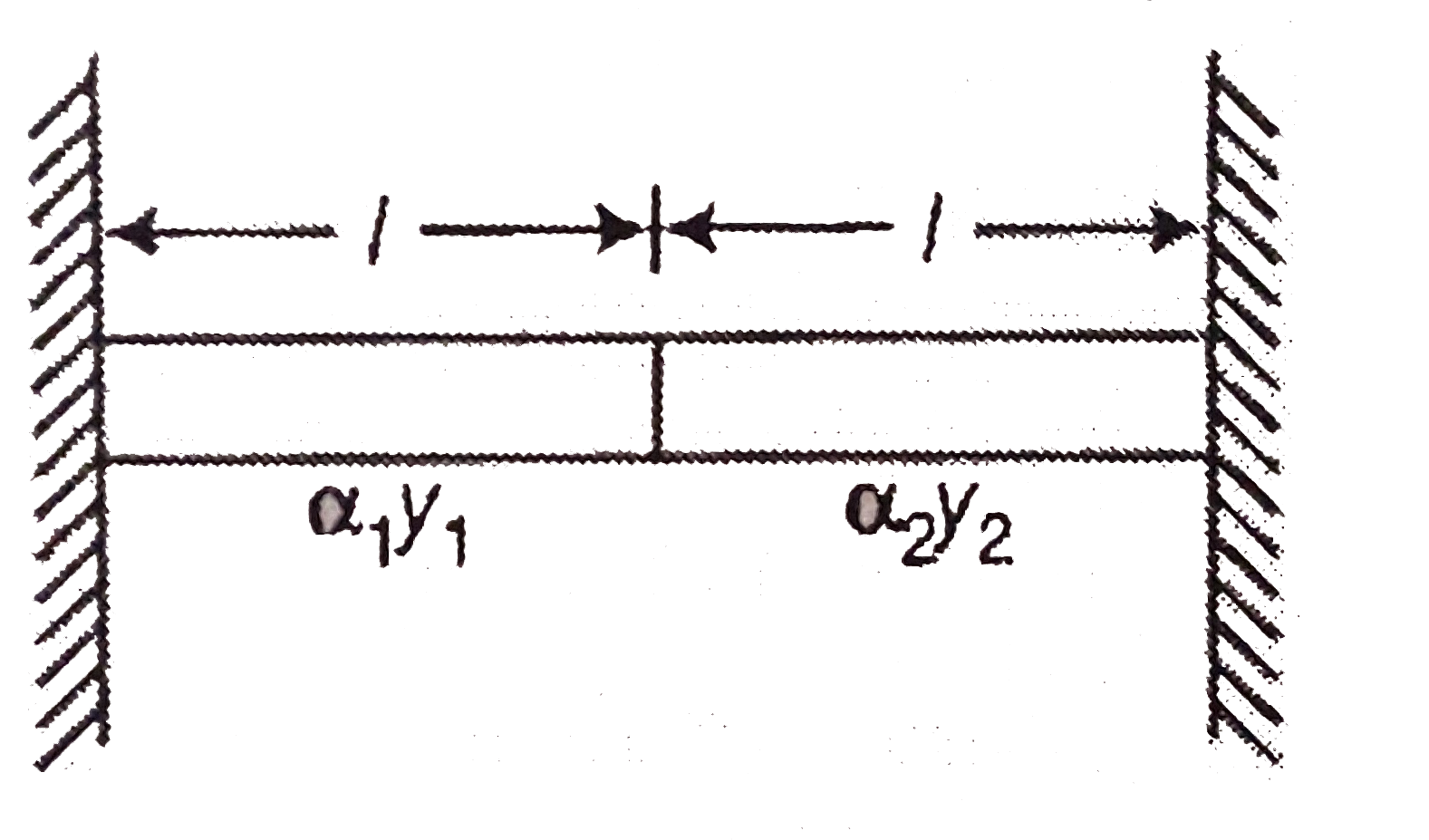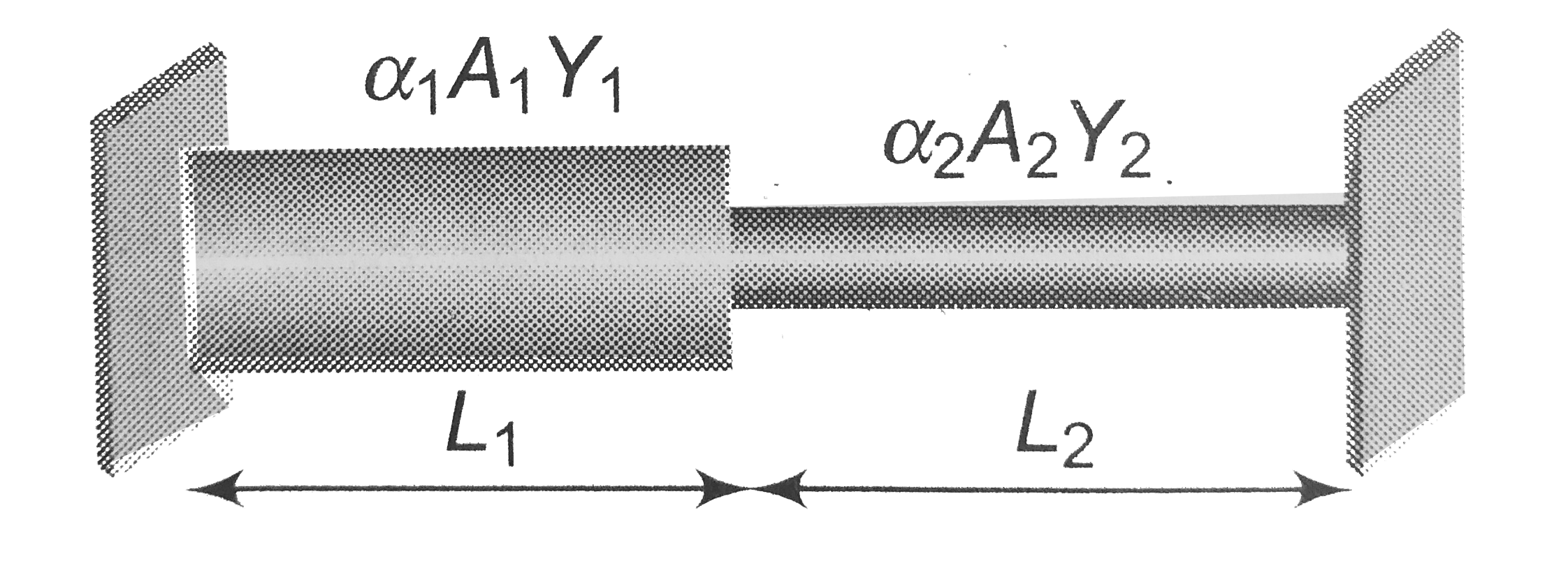Two ,netal rods are fixed end to end between two rigid supports as shown in figure. Each rod is of length land area of cross -section is A. When the system is heated up, detennine the condition when the junction between rods does not shift ? (Given : Y1andY2 are Young's modulus of ,naterials of the rods, α1andα2 are coefficients of linear expansion )

Since, each rod is prevented from expansion so, they are under compression and mechanical strain The net strain in each rod.
ε1=α11ΔT−FlAY1,ε2=α2lΔT−FlAY2
ε1=ε2=0
α11ΔT−FlAY1=0andα2lΔT−FlAY2=0
α1lΔT−FlAY1=0andα11ΔT−FlAY2=0
Solving , we get α1Y1=α2Y2
Similar Questions
Two metal rods are fixed end to end between two rigid supports as shown in figure. Each rod is of length l and area of cross-section is A. When the systeam is heated up,datermine the condition when the juncation between rods does not shift ? (Y1 and Y2 are Young's modulus of materials of rods, α1 and α2 are coefficients of linear expansion)
_S01_022_Q01.png)
View SolutionTwo metal rods of the same length and area of cross-section are fixed end to end between rigid supports. The materials of the rods have Young moduli Y1 and Y2 , and coefficient of linear expansion α1 and α2 . The junction between the rod does not shift and the rods are cooled
View Solution
Knowledge Check
Two metal rods are fixed end to end between two rigid supports, as shown in figure. Each rod is of length 'l' and area of cross-section is A. When the system is heated up, determine the conditioin whenthe juction between rods does not shift.
[Given, Y1 and Y2 are Young's modulus of materials of the rods, α1 and α2 are coefficient at linear expansion.
 A(α1Y2Bα1Y1=α2Y2Cα1=α2DY1=Y2
A(α1Y2Bα1Y1=α2Y2Cα1=α2DY1=Y2Two metal rods are fixed end to end between two rigid supports, as shown in figure. Each rod is of length l and area of cross-section is A. When the system is heated up, determine the condition that the junction between rode not shift. [Given Y1andY2 are Young's modulus of materials of teh rods while α1andα2 are coefficient of linear expansion]
 Aα1Y2=α2Y1Bα1Y1=α2Y2Cα1=α2DY1=Y2
Aα1Y2=α2Y1Bα1Y1=α2Y2Cα1=α2DY1=Y2Two rods having length l1 and l2, made of materials with the linear coefficient of expansion α1 and α2 were welded togther. The equivalent coefficients of linear expansion for the obtained rod:-
 Al1α2+l2α1l1+l2Bl1α1+l2α2α1+α2Cl1α1+l2α2l1+l2Dl2α1+l1α2α1+α2
Al1α2+l2α1l1+l2Bl1α1+l2α2α1+α2Cl1α1+l2α2l1+l2Dl2α1+l1α2α1+α2
Two rods are joined between fixed supports as shown in the figure. Condition for no change in the length of individual rods with the increase of temperature will be
(α1,α2= linear expansion coefficient
A1,A2= Area of rods
Y1,Y2= Young modulus )

View SolutionTwo rods are joined between fixed supports as shown in the figure. Condition for no change in the length of individual rods with the increase of temperature will be
(α1,α2= linear expansion coefficient
A1,A2= Area of rods
Y1,Y2= Young modulus )

View SolutionTwo rods having length l1andl2 made of materials with the linear expansion coefficient α1andα2 were soldered together. The equivalent coefficients of linear expansion for the obtained rod
View SolutionTwo rods of lengths L1 and L2 are welded together to make a composite rod of length (L1+L2). If the coefficient of linear expansion of the materials of the rod are α1 and α2 respectively. The effective coefficient of linear expansion of the composite rod is
View SolutionTwo metal rods of the same length and area of cross-section are fixed end to end between rigid supports. The materials of the rods have Young module Y1 and Y2 , and coefficient of linear expansion α1 and α2 . The junction between the rod does not shift and the rods are cooled
View Solution
